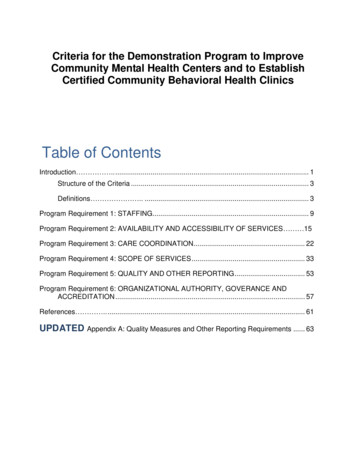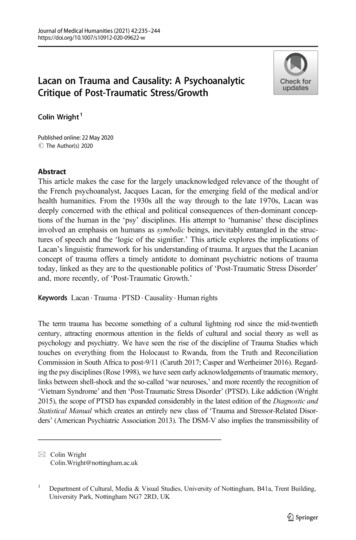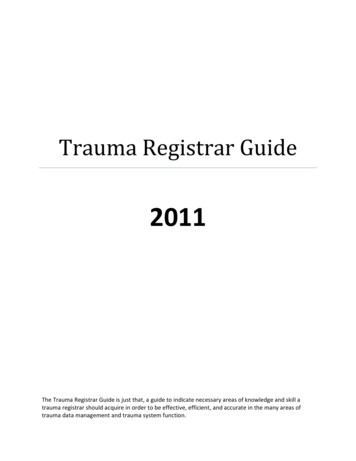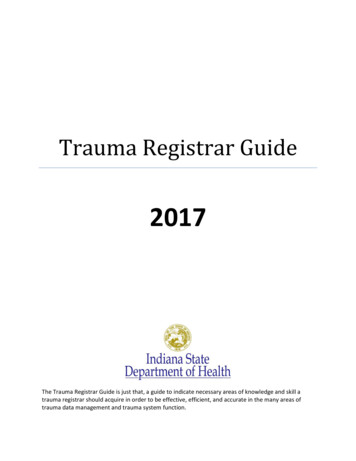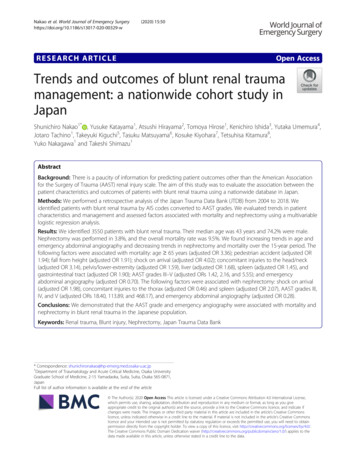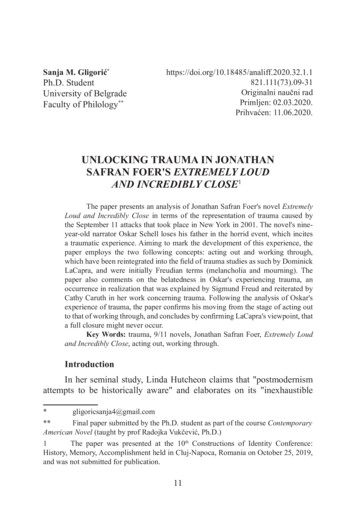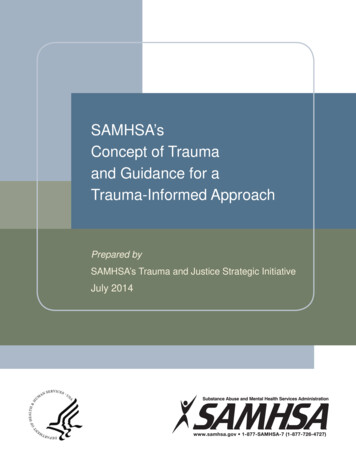
Transcription
SAMHSA’sConcept of Traumaand Guidance for aTrauma-Informed ApproachPrepared bySAMHSA’s Trauma and Justice Strategic InitiativeJuly 2014
U.S. Department of Health and Human ServicesSubstance Abuse and Mental Health Services AdministrationOffice of Policy, Planning and Innovation
AcknowledgementsThis publication was developed under the leadership of SAMHSA’s Trauma andJustice Strategic Initiative Workgroup: Larke N. Huang (lead), Rebecca Flatow, TenlyBiggs, Sara Afayee, Kelley Smith, Thomas Clark, and Mary Blake. Support wasprovided by SAMHSA’s National Center for Trauma-Informed Care, contract number270-13-0409. Mary Blake and Tenly Biggs serve as the CORs.DisclaimerThe views, opinions, and content of this publication are those of the authors and do notnecessarily reflect the views, opinions, or policies of SAMHSA or HHS.Public Domain NoticeAll materials appearing in this volume except those taken directly from copyrightedsources are in the public domain and may be reproduced or copied without permissionfrom SAMHSA or the authors. Citation of the source is appreciated. However, thispublication may not be reproduced or distributed for a fee without the specific, writtenauthorization of the Office of Communications, SAMHSA, Department of Health andHuman Services.Electronic Access and Copies of PublicationThe publication may be downloaded or ordered from SAMHSA’s Publications OrderingWeb page at http://store.samhsa.gov. Or, please call SAMHSA at 1-877-SAMHSA-7(1-877-726- 4727) (English and Español).Recommended CitationSubstance Abuse and Mental Health Services Administration. SAMHSA’s Conceptof Trauma and Guidance for a Trauma-Informed Approach. HHS Publication No.(SMA) 14-4884. Rockville, MD: Substance Abuse and Mental Health ServicesAdministration, 2014.Originating OfficeOffice of Policy, Planning and Innovation, Substance Abuse and Mental HealthServices Administration, 1 Choke Cherry Road, Rockville, MD 20857. HHS PublicationNo. (SMA) 14-4884. Printed 2014.
ContentsIntroduction .2Purpose and Approach: Developing a Framework for Traumaand a Trauma-Informed Approach .3Background: Trauma — Where We Are and How We Got Here .5SAMHSA’s Concept of Trauma .7SAMHSA’s Trauma-Informed Approach: Key Assumptionsand Principles .9Guidance for Implementing a Trauma-Informed Approach .12Next Steps: Trauma in the Context of Community .17Conclusion .17Endnotes .18page 1
IntroductionTrauma is a widespread, harmful and costly publichealth problem. It occurs as a result of violence,abuse, neglect, loss, disaster, war and otheremotionally harmful experiences. Trauma has noboundaries with regard to age, gender, socioeconomicstatus, race, ethnicity, geography or sexual orientation.It is an almost universal experience of people withmental and substance use disorders. The needto address trauma is increasingly viewed as animportant component of effective behavioral healthservice delivery. Additionally, it has become evidentthat addressing trauma requires a multi-pronged,multi-agency public health approach inclusive ofpublic education and awareness, prevention andearly identification, and effective trauma-specificassessment and treatment. In order to maximize theimpact of these efforts, they need to be providedin an organizational or community context that istrauma-informed, that is, based on the knowledgeand understanding of trauma and its far-reachingimplications.supports and intervention, people can overcometraumatic experiences.6,7,8,9 However, most people gowithout these services and supports. Unaddressedtrauma significantly increases the risk of mentaland substance use disorders and chronic physicaldiseases.1,10,11With appropriate supports andintervention, people can overcometraumatic experiences.Individuals with experiences of trauma are foundin multiple service sectors, not just in behavioralhealth. Studies of people in the juvenile and criminaljustice system reveal high rates of mental andsubstance use disorders and personal histories oftrauma.12,13 Children and families in the child welfaresystem similarly experience high rates of trauma andassociated behavioral health problems.5,14 Youngpeople bring their experiences of trauma into theschool systems, often interfering with their schoolsuccess. And many patients in primary care similarlyhave significant trauma histories which has an impacton their health and their responsiveness to healthinterventions.15,16,17The need to address trauma isincreasingly viewed as an importantcomponent of effective behavioralhealth service delivery.In addition, the public institutions and service systemsthat are intended to provide services and supportsto individuals are often themselves trauma-inducing.The use of coercive practices, such as seclusion andrestraints, in the behavioral health system; the abruptremoval of a child from an abusing family in the childwelfare system; the use of invasive procedures in themedical system; the harsh disciplinary practices ineducational/school systems; or intimidating practicesin the criminal justice system can be re-traumatizingfor individuals who already enter these systemswith significant histories of trauma. These programor system practices and policies often interfere withachieving the desired outcomes in these systems.The effects of traumatic events place a heavyburden on individuals, families and communities andcreate challenges for public institutions and servicesystems. Although many people who experiencea traumatic event will go on with their lives withoutlasting negative effects, others will have moredifficulty and experience traumatic stress reactions.Emerging research has documented the relationshipsamong exposure to traumatic events, impairedneurodevelopmental and immune systems responsesand subsequent health risk behaviors resulting inchronic physical or behavioral health disorders.1,2,3,4,5Research has also indicated that with appropriatepage 2
Thus, the pervasive and harmful impact of traumaticevents on individuals, families and communities andthe unintended but similarly widespread re-traumatizingof individuals within our public institutions andservice systems, makes it necessary to rethinkdoing “business as usual.” In public institutions andservice systems, there is increasing recognition thatmany of the individuals have extensive histories oftrauma that, left unaddressed, can get in the way ofachieving good health and well-being. For example,a child who suffers from maltreatment or neglect inthe home may not be able to concentrate on schoolwork and be successful in school; a women victimizedby domestic violence may have trouble performing inthe work setting; a jail inmate repeatedly exposed toviolence on the street may have difficulty refrainingfrom retaliatory violence and re-offending; a sexuallyabused homeless youth may engage in self-injury andhigh risk behaviors to cope with the effects of sexualabuse; and, a veteran may use substances to maskthe traumatic memories of combat. The experiencesof these individuals are compelling and, unfortunately,all too common. Yet, until recently, gaining a betterunderstanding of how to address the traumaexperienced by these individuals and how to mitigatethe re-traumatizing effect of many of our publicinstitutions and service settings was not an integralpart of the work of these systems. Now, however,there is an increasing focus on the impact of traumaand how service systems may help to resolve orexacerbate trauma-related issues. These systems arebeginning to revisit how they conduct their “business”under the framework of a trauma-informed approach.There is an increasing focuson the impact of traumaand how service systems mayhelp to resolve or exacerbatetrauma-related issues. Thesesystems are beginning torevisit how they conduct theirbusiness under the framework ofa trauma-informed approach.Purpose and Approach: Developing a Framework for Traumaand a Trauma-Informed ApproachPURPOSEframework be relevant to its federal partners andtheir state and local system counterparts and topractitioners, researchers, and trauma survivors,families and communities. The desired goal is to builda framework that helps systems “talk” to each other,to understand better the connections between traumaand behavioral health issues, and to guide systems tobecome trauma-informed.The purpose of this paper is to develop a workingconcept of trauma and a trauma-informed approachand to develop a shared understanding of theseconcepts that would be acceptable and appropriateacross an array of service systems and stakeholdergroups. SAMHSA puts forth a framework for thebehavioral health specialty sectors, that can beadapted to other sectors such as child welfare,education, criminal and juvenile justice, primaryhealth care, the military and other settings that havethe potential to ease or exacerbate an individual’scapacity to cope with traumatic experiences. Infact, many people with behavioral health problemsreceive treatment and services in these non-specialtybehavioral health systems. SAMHSA intends thisAPPROACHSAMHSA approached this task by integrating threesignificant threads of work: trauma focused researchwork; practice-generated knowledge about traumainterventions; and the lessons articulated by survivorspage 3
of traumatic experiences who have had involvementin multiple service sectors. It was expected thatthis blending of the research, practice and survivorknowledge would generate a framework for improvingthe capacity of our service systems and publicinstitutions to better address the trauma-related issuesof their constituents.The key questions addressedin this paper are: What do we mean by trauma? What do we mean by a trauma-informedapproach?To begin this work, SAMHSA conducted anenvironmental scan of trauma definitions and modelsof trauma informed care. SAMHSA convened agroup of national experts who had done extensivework in this area. This included trauma survivorswho had been recipients of care in multiple servicesystem; practitioners from an array of fields, who hadexperience in trauma treatment; researchers whosework focused on trauma and the development oftrauma-specific interventions; and policymakers in thefield of behavioral health. What are the key principles of a traumainformed approach? What is the suggested guidance forimplementing a trauma-informedapproach? How do we understand trauma in thecontext of community?From this meeting, SAMHSA developed a workingdocument summarizing the discussions among theseexperts. The document was then vetted amongfederal agencies that conduct work in the field oftrauma. Simultaneously, it was placed on a SAMHSAwebsite for public comment. Federal agency expertsprovided rich comments and suggestions; the publiccomment site drew just over 2,000 respondentsand 20,000 comments or endorsements of others’comments. SAMHSA reviewed all of these comments,made revisions to the document and developed theframework and guidance presented in this paper.SAMHSA’s approach to this task has been an attemptto integrate knowledge developed through researchand clinical practice with the voices of traumasurvivors. This also included experts funded throughSAMHSA’s trauma-focused grants and initiatives,such as SAMHSA’s National Child Traumatic StressInitiative, SAMHSA’s National Center for TraumaInformed Care, and data and lessons learned fromother grant programs that did not have a primary focuson trauma but included significant attention to trauma,such as SAMHSA’s: Jail Diversion Trauma Recoverygrant program; Children’s Mental Health Initiative;Women, Children and Family Substance AbuseTreatment Program; and Offender Reentry and AdultTreatment Drug Court Programs.page 4
Background: Trauma — Where We Are and How We Got HereThe concept of traumatic stress emerged in thefield of mental health at least four decades ago.Over the last 20 years, SAMHSA has been a leaderin recognizing the need to address trauma as afundamental obligation for public mental health andsubstance abuse service delivery and has supportedthe development and promulgation of trauma-informedsystems of care. In 1994, SAMHSA convened theDare to Vision Conference, an event designed tobring trauma to the foreground and the first nationalconference in which women trauma survivors talkedabout their experiences and ways in which standardpractices in hospitals re-traumatized and often,triggered memories of previous abuse. In 1998,SAMHSA funded the Women, Co-Occurring Disordersand Violence Study to generate knowledge on thedevelopment and evaluation of integrated servicesapproaches for women with co-occurring mental andsubstance use disorders who also had histories ofphysical and or sexual abuse. In 2001, SAMHSAfunded the National Child Traumatic Stress Initiative toincrease understanding of child trauma and developeffective interventions for children exposed to differenttypes of traumatic events.Simultaneously, an emerging trauma survivorsmovement has provided another perspective on theunderstanding of traumatic experiences. Traumasurvivors, that is, people with lived experienceof trauma, have powerfully and systematicallydocumented their paths to recovery
status, race, ethnicity, geography or sexual orientation. diseases. 1,10,11 It is an almost universal experience of people with mental and substance use disorders. The need to address trauma is increasingly viewed as an important component of effective behavioral health service delivery. Additionally, it has become evident that addressing trauma requires a multi-pronged, multi-agency
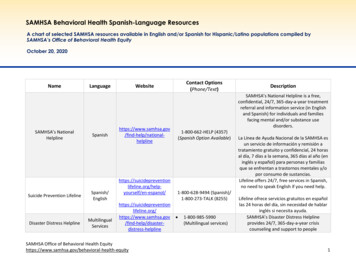
![[NAME OF STATE] - SAMHSA](/img/8/state-certification-guide.jpg)
